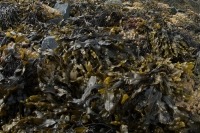
(Photo: Claire Goodwin)
Bladder Wrack
Fucus vesiculosus
This seaweed is olive-brown. It grows from a holdfast that attaches onto rock. It has a flattened frond which branches evenly in two. There are air-filled bladders along its length. These are in pairs on either side of a pronounced mid-rib. The edges of the frond are not serrated. Individuals can reach one metre in length but are usually under 50 centimetres. The bladders let the fronds float up in the water column when the tide is in. When the tide is out, the seaweed lies over the ground.
Authority
Linnaeus, 1753
Classification Details
Phylum: Ochrophyta (brown multi and unicellular algae); Class: Phaeophyceae (brown seaweeds).
Habitat
Found on both sides of the North Atlantic. In North America it is present from the Arctic down to Maryland. Found in the intertidal zone. In sheltered areas, rockweed (Ascophyllum nodosum) tends to dominate and Fucus species are limited to small patches. They become more dominant on more exposed coasts.
Diet
Photosynthetic. Uses compounds called pigments in its tissue to capture energy from sunlight. The major pigments used are chlorophyll a, chlorophyll c1 and c2, and fucoxanthin. The seaweed then uses the light energy to turn water and carbon dioxide into sugar.
Reproduction
Separate sexes - each plant is either male or female. Plants hold eggs or sperm in receptacles on the sides of their fronds. They release them into the water and fertilization is external. Growth of adult plants is fastest in late summer and autumn when they can grow two to six centimetres per month. Plants live for around two years.
Fun Facts
Fucus seaweeds contain a lot of Iodine and have been used in traditional medicine to treat goitre (thyroid swelling) and obesity.
Scientists have found that bioactive compounds (chemicals) from this genus of seaweeds have potential to treat cellulite, blood clot formations, rheumatoid arthritis, asthma, diabetes, psoriasis and other skin diseases, and even cancer
References
Catarino MD, Silva AMS and Cardoso SM (2018) Phycochemical constituents and biological activities of Fucus sp. Marine Drugs 16 (8), 249.
Guiry MD (2020) Fucus vesiculosus. In: Guiry MD & Guiry GM (eds) AlgaeBase. World-wide electronic publication, National University of Ireland, Galway. https://www.algaebase.org/search/species/detail/?species_id=87 Accessed 22 June 2020.
Keser M and Larson BR (1984) Colonization and growth dynamics of three species of Fucus. Marine Ecology Progress Series 15, 125–134.
White N (2008) Fucus vesiculosus Bladder wrack. In Tyler-Walters H. and Hiscock K. (eds) Marine Life Information Network: Biology and Sensitivity Key Information Reviews, [on-line]. Plymouth: Marine Biological Association of the United Kingdom. Available from: https://www.marlin.ac.uk/species/detail/1330 Accessed 19 June 2020.


